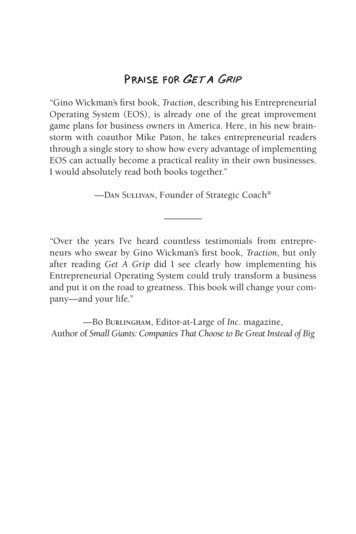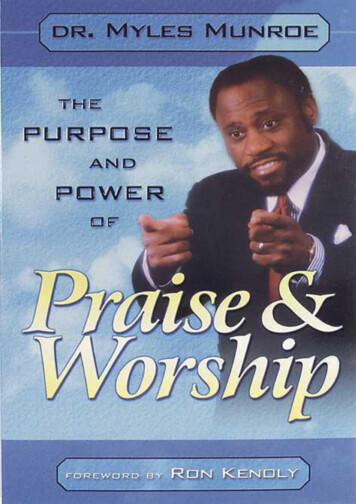
Transcription
Praise for Get A Grip“Gino Wickman’s first book, Traction, describing his EntrepreneurialOperating System (EOS), is already one of the great improvementgame plans for business owners in America. Here, in his new brainstorm with coauthor Mike Paton, he takes entrepreneurial readersthrough a single story to show how every advantage of implementingEOS can actually become a practical reality in their own businesses.I would absolutely read both books together.”—Dan Sullivan, Founder of Strategic Coach ————“Over the years I’ve heard countless testimonials from entrepreneurs who swear by Gino Wickman’s first book, Traction, but onlyafter reading Get A Grip did I see clearly how implementing hisEntrepreneurial Operating System could truly transform a businessand put it on the road to greatness. This book will change your company—and your life.”—Bo Burlingham, Editor-at-Large of Inc. magazine,Author of Small Giants: Companies That Choose to Be Great Instead of Big
.BENBELLA BOOKS, INC.dallas, texas
This book is a work of fiction. Names, characters, places and incidents are the productof the author’s imagination and are used fictitiously. Any resemblance to actual events,locales or persons, living or dead, is coincidental. Copyright 2012 Gino Wickman and Mike PatonAll rights reserved. No part of this book may be reproduced or transmitted in any formor by any means, electronic or mechanical, including photocopying, recording, or by anyinformation storage and retrieval system without the prior written permission of theauthor, except for the inclusion of brief quotations in critical reviews and certain other noncommercial uses permitted by copyright law. For permission requests, contact the publisher.The EOS ModelTM, The V/TOTM, The Meeting PulseTM, The “Level 10” MeetingTM, TheIssues Solving TrackTM, LMATM, The People AnalyzerTM, GWCTM, Delegate and ElevateTM,The Three-Step Process DocumenterTM, The EOS Process and The Six KeyComponentsTM are trademarks of Gino Wickman. EOS and The EntrepreneurialOperating System are registered trademarks of Gino Wickman. All rights reserved.BenBella Books, Inc.10300 N. Central ExpresswaySuite 400Dallas, TX 75231www.benbellabooks.comSend feedback to feedback@benbellabooks.comPrinted in the United States of America10 9 8 7 6 5 4 3 2 1Library of Congress Cataloging-in-Publication Data is available for this title.ISBN 978-1-937856-08-3Copyediting by Rebecca LoganProofreading by Michael Fedison and Jenny BridgesCover design by Facout StudioText design and composition by John Reinhardt Book DesignPrinted by Berryville Graphics, Inc.Distributed by Perseus Distribution(www.perseusdistribution.com)To place orders through Perseus Distribution:Tel: 800-343-4499Fax: 800-351-5073E-mail: orderentry@perseusbooks.comSignificant discounts for bulk sales are available.Please contact Glenn Yeffeth at glenn@benbellabooks.com or 214-750-3628.
To my mom, Linda Wickman, the strongest person I know.—Gino WickmanTo “Pop,” Art Pfeil, the storyteller and teacher in me.—Mike Paton
vii
HIS IS A BUSINESS FABLE, but it’s not like any business fableyou’ve read before. Though fictional, Get A Grip is a gritty,real-world story about an entrepreneurial company that has hit theceiling. Tired and frustrated, its leaders respond by implementing apractical, proven system that dramatically improves the performanceof their business and the quality of their lives.That system is called EOS, the Entrepreneurial Operating System.It’s not theory. It’s not full of abstract concepts. It’s not about onebig idea. Rather, it’s a complete system full of simple, practical toolsthat has helped thousands of entrepreneurs worldwide get what theywant from their businesses.We’ve personally taken hundreds of companies through this process. If the details ring true it’s because we really didn’t make upanything. Any similarities to issues you face with your organization,leadership team, or people are pure coincidence. This book isn’tbased on a true story; it’s actually based on hundreds of true stories.There isn’t one situation you will read about that we haven’t experienced at least twenty times with various clients.We hope these realistic characters and familiar situations helpyou see how to solve the most important and common issues youface as a leader. These practical tools will help you simplify, clarify,and achieve your vision. We’re confident they will because—overand over again—we’ve seen that the results of implementing EOS are1
2\ Get a Griptruly remarkable. But don’t take our word for it. We’ll let the businessowners who’ve implemented it speak for themselves:“In the ten years prior to implementing EOS, our company experienced substantial and consistent revenue growth year after year.But we hit a ceiling. Our leaders weren’t on the same page, therewas confusion about direction and roles, finger pointing, and turfprotecting—profit dropped considerably. It wasn’t fun. EOS hashelped us develop a trusting, engaged, focused, and empoweredleadership team. We’re growing again, expanding our facilities,acquiring companies, and delivering more consistently to our customers. Best of all, we’ve been profitable, even through the toughyears, and I am able to truly strategize our long-term path insteadof concentrating on present-day issues. On a one-to-ten scale, I givethe whole experience a ten (and I don’t give many tens).”Joe CekolaPresident, Imperial Beverage“Prior to beginning our EOS journey, issues small and large oftengot in the way of our growth. Implementing EOS has helped us seethese issues and resolve them. We now have a phenomenal (andvery clear) vision for our firm, the right structure to take us to thenext level, and are hiring strategically based on our Core Valuesso that we have the right people in the right seats. We’ve grown25 percent or more in each of the last three years and, perhapsmore importantly, are enjoying the ride. We look forward to working hard with a great team, but are increasingly able to disengageat the end of the day and spend quality time with our families. Itdoesn’t get much better.”Dave KolbCEO, Global Tax Network“After twenty-seven years of business, a downturn in the economy,and a new management team, adopting EOS was exactly what weneeded at Brogan & Partners. Through the process, we have expedited our decision making, enabling us to get far more done in ashorter period of time. Simply, the process has helped us make the
The Incident/ 3hard decisions that are right for our business. Not only has EOShelped us uncover our true culture, it has helped our company liveby those values. Brogan & Partners is stronger, the managementteam is more accountable, and we are seeing the results with aninflux of new clients, more income, and a better bottom line.”Ellyn DavidsonManaging Partner, Brogan & Partners“Five years ago we ended the year at 5 million in revenue and a3 percent net loss. Things weren’t awful, but we definitely wantedto do better, so we implemented EOS. It felt a little awkward atfirst, but as we began to master the system, things became simplerand everything began to work better. As a result, we ended the nextyear at 7,500,000 with a 6 percent net profit! The whole leadership team is so much more confident about the future now, andwe’ve never been so unified as a team. I guess the big ‘WOW!’ in allof this is knowing that our dreams are attainable. We’re on pace toclose out this year at 18 million with a nice profit. EOS works.”Steve SpiechSpiech Farms“Though growing quickly, profitable, and entirely self-funded afterthree years in business, my partner and I realized things weren’tperfect. We had a murky vision, plenty of stress, and a strainedpartnership. Implementing EOS changed all that. For the first timewe had clarity and accountability. We began managing our growthin a way that wouldn’t cost us our friendship or financial stability.Two short years after seriously doubting the future of our business,it is stronger and growing faster than ever. The results speak forthemselves. Sales have grown from 2.2 million to more than 7million in two short years, and we are #258 on the Inc. 500. Best ofall, we run a stable, profitable business and we’re still having fun.”Andrew DunemanOwner, Bulk Reef Supply“Dietz Property Group (DPG) has been implementing EOS forjust over two years coming out of the Great Recession. During this
4\ Get a Gripperiod, we grew 44 percent by picking up six new third-party engagements and acquiring three new properties—after being stagnant for a couple of years. EOS has also helped position us forfuture growth. We are a much stronger, clearer, simpler, more cohesive organization than before we started with EOS.”Brian DietzPresident, Dietz Property Group“Lowry Computer Products is celebrating our one-year anniversary of being engaged in the EOS process and have committed tothe process for our future. The process has helped us solidify ourvision and streamlined the execution of our vision. As a result, ourcompany has accomplished major milestones in propelling growthand employee satisfaction, and reaching all of our goals successfully. We grew three times the rate of our industry average this year.”Mike LowryPresident/CEO, Lowry Computer Products“Our business had enjoyed sixty-plus years of success prior to implementing EOS with a ‘shoot from the hip’ way of doing business.As we grew, however, that approach created inconsistency and inefficiencies as each of our locations developed their own way of doingthings and each became like separate businesses. We realized thatwould make it very difficult for us to continue growing profitably.EOS has given us the structure, discipline, and accountability to geteveryone in the organization on the same page and working hard toachieve a common vision. We waste less time, identify and resolveissues as a healthy, cohesive team, and we get more done.”Tom BohlsVice President, Buckeye Power Sales“EOS was the catalyst for one of the most remarkable changes inmy company. My leadership team has integrated the EOS toolsinto our everyday work habits. Our vision is clear, and strategies are well-executed and communicated to all. EOS taught myleadership team how to plan, act, and communicate in a systemthat is easy for all to adopt and follow. Within the first year of
The Incident/ 5integrating EOS, my company was able to achieve a record revenue growth of 87 percent over the prior year.”Randy PruittPresident, Randall Industries, Inc.Get A Grip is not designed to just give you something to thinkabout. It’s thorough enough to help you and your leadership teamfully implement the tools described in this fable and achieve resultslike those of the companies above. We could have written this bookas a straightforward description of EOS (in fact, its companion book,Traction, does exactly that). But we believe that for many readers, observing a company actually implementing EOS will make the processeasier to follow and apply. It also provides greater insights into therealities of implementation.When we decided to write this book, it was a true passion project.As we started to write, the words and situations flowed out of us likewater. The reason is that this is what we do. Every day we are in the realworld, helping entrepreneurial leadership teams of small to mid-sizedcompanies achieve the results you will read about. Nothing is made up.There is not one ounce of theory. Together we have delivered almosttwo thousand full-day sessions with almost two hundred companies.Our passion and obsession is you, the entrepreneurial leader. Youtake risks, you build remarkable things, and you suffer. Helpingyou get everything you want from your business is why we exist.We are here to help you permanently resolve the root cause of yourissues, to build something greater, and live the life you want anddeserve. EOS was created for you by someone just like you. You arereal, raw, and lay it on the line every day with no safety nets and noBS. We feel you deserve a solution worthy of who you are and howyou operate.We believe Get A Grip will give you everything you need totransform the performance of your business. But if you need morere sources, like free downloadable tools and an entrepreneurial community to access, or you want to find a Certified EOS Implementer inyour area, you can access them at www.eosworldwide.com. But let’snot get ahead of ourselves. Turn the page, start reading, and beginthe process of truly getting a grip on your business.
ITTING IN HER CAR, Eileen Sharp stared intently at Vic’s SUVparked across the lot. For a brief moment, she envisioned gunning the engine and ramming it. The hint of a smile appeared at thecorners of her mouth.Eileen was angry and frustrated with Vic. For the first time, shethought of ending the partnership with her childhood friend. After afew moments, she gathered herself and regained some resolve.“I’m not walking away from what we’ve built these last ten years,”Eileen said under her breath. “You don’t just turn your back on a 7million company and thirty-five employees.”Still, what her business partner had done in the meeting was anew low. The fact that he had said it in front of the other leaders wasunforgivable. She couldn’t just let it go.Suddenly Eileen realized she was late for the Business Roundtablereception. She took a deep breath and checked herself in the rearview mirror. As she pulled out of the parking lot, she muttered, “Thatson of a bitch.”Four hours earlier, at 1:00 p.m., Eileen had rushed into the conference room carrying her laptop and a mound of paperwork.Determined to begin Swan Services’ quarterly executive committeemeeting on time for once, she had scurried around all morning andskipped lunch to prepare the presentation and numerous reports thatwould tell the story of the last eighteen months.7
8\ Get a GripThis had been the first tough stretch in Swan Services’ history.Until the last year and a half, the company had been profitable andhad grown quickly. Swan was still doing well, but the steady growthhad stopped. Everything seemed to be getting more difficult: winning new customers, keeping them happy, operating profitably—youname it. She had always taken pride in her work ethic, but recentlythe demands of her business required so much attention that sheregularly missed important events with her husband and two children. For the first time, Eileen was frustrated, and she could tell thatother members of the team were frustrated, too.Eileen burst through the conference room door ready to apologize,once again, for being late. Instead, she found only two of her five colleagues. Sue Meecham, Swan’s vice president of sales, was reviewingthe latest pipeline numbers. Eileen’s longtime friend and business associate and the acting director of marketing, Art Pearson, was stowing his overcoat and briefcase in the corner of the conference room.“Hello, Sue. Hi, Art. Any sign of the others?” she asked.“No,” replied Sue. “Unless you count Evan racing by a minute agoand looking relieved to see he wasn’t the only one late.”Eileen rolled her eyes, dropped her materials at the front of thetable, and asked Art to help connect her laptop to the LCD projector. In walked Carol Henning, Swan’s controller. Eileen distributedpresentation folders to the three executives and began bringing upthe PowerPoint presentation she had prepared. Vice President ofOperations Evan McCullough entered looking rushed and disheveled.And then the team waited.Vic finally strolled through the door at 1:14, still in the middle ofan animated phone conversation with what sounded like a prospective client. He made a few exaggerated gestures to the rest of theteam, making it clear he was attempting to end the call. Eventuallyhe hung up, sat down, and apologized as only Vic could.“Sorry, guys. That was the procurement guy at ShorelineIndustries,” he said. “I’ve been trying to pry that deal out of his handsand back under the control of our buyer for so long, I think we useda slide rule to put the bid together.”The entire team laughed—even Eileen. She tossed her foundingpartner and CEO a folder, strode to the front of the room, grabbed
The Incident/ 9the remote control, and launched into her presentation. Over thenext sixty minutes, she detailed the troubling signs that had developed in the five quarters since the company’s breakout year: In Swan’s eighth full year, revenues grew at a record pace andexceeded 7 million for the first time. However, the companyhadn’t managed to hit its quarterly revenue goals since. Againstprojected growth of 14 percent, revenue had grown only 1.5percent in the previous year and was flat in Q1 this year. Profitability had taken a beating. On the heels of a great year,the team had invested heavily in a foundation for furthergrowth. Those investments had not yet paid off. Pinpointing the cause of these problems had been difficult.Eileen had been studying the issue for three quarters and nowfelt comfortable sharing her findings with the team: Swan’s sales team had missed its new revenue goal inthree of the last five quarters. Existing customers had begun leaving—a new phenomenon. At first the occasional defections seemed trivial, butthe trend was disconcerting. Labor costs had increased significantly. Swan had begunadding people and upgrading talent last year in an effortto ramp up to its five-year goal of 20 million in revenue. Despite the company’s paying more for talent, a couplekey employees had resigned abruptly in recent months.Neither cited internal issues in exit interviews, but Eileenhad come to believe that Swan’s once great culture—onedevoted to being a genuinely fun place to work hard andget great results—had begun eroding.None of these issues was new. The team had discussed each oneat some length in prior quarterly meetings, often staying late into thenight and ordering pizza, but rarely reaching agreement on anything,much less a plan of action. The prevailing sense was that the primarycause of all of these issues was somehow outside of their control.One quarter, the economy was to blame. The next, it was the software conversion. Last quarter, Vic had actually used the terms “bad
10\ Get a Gripmojo” and “funk” in an attempt to quantify the problem, suggestingthat the company had lost its “Midas touch.”“Dwelling on all this bad news drags us down,” he had said, staring directly at Eileen. “We’ve lost our swagger, and—while I knowsome of you will dismiss this as metaphysical mumbo jumbo—I’mconvinced that we have to get that swagger back at all costs.”At the time Eileen had taken Vic’s observation in stride. She hadlearned long before to ignore his constant baiting and avoid gettingsucked into titanic battles over trivial matters. Instead, Eileen hadanalyzed the situation thoroughly and carefully prepared her planof attack for today’s meeting. She had entered the conference roomintent on staying positive and focusing on solutions to the thirteenthings she believed the executive committee actually could control.But first, she needed to present her mountain of evidence to convincethem that Swan had a right to expect more.Eileen methodically made her case; the data was irrefutable. Despitea larger budget, Swan’s marketing efforts had produced fewer qualifiedleads. The sales team’s close ratio had declined, and it had more frequentlyoffered discounted pricing on the deals it had won. In operations, revenues per employee had fallen, while errors and missed deadlines were up.As she walked through the troubling details, Eileen saw the moodin the conference room change. Arms were uncrossed. Heads began tonod. Notes were taken. Near the end of her presentation, Vic pushedhimself away from the conference table and held his hands up dramatically, as though he had eaten too much at Thanksgiving dinner.“No mas, boss,” he said with a smile. “We get it.”When the laughter subsided, Eileen suggested the team take aquick break and return ready to start solving problems. In high spirits, she headed for the ladies’ room. That’s where a nightmare scenario began to unravel.Eileen heard someone slide quickly into the restroom before theswinging door closed behind her.“Um, Eileen?”“Yes, Sue—what is it?” said the startled leader.“I don’t know exactly how to say this,” she began. “So I’ll just spitit out. I think it would be best for all concerned if I left Swan, effective immediately.”
The Incident/ 11Eileen was floored. She considered Sue a shining star—and an integral part of Swan’s future. Since joining the company two yearsbefore, after a successful stint selling for a competitor, the young VPof sales had been a tireless and skilled asset. She consistently workedharder and got better results than anyone else in the organizationand had recently been rewarded with a promotion.“Wha—I mean, why?” Eileen stammered.“It’s clear to me that I’m the problem,” Sue said, straining. “Youand Vic promoted me nine months ago. Since then our team hasn’thit a single sales goal. I haven’t even hit my own sales goals! On therare occasion that we do win a deal, we seem to be screwing that up,too.” She turned and splashed cold water on her face.“What in the world do you mean, Sue?” she cried. “Of all the people in that room, you’re the least of my worries!”“I don’t know how you can say that, Eileen. Every slide in yourpresentation hit me like a ton of bricks! We’re not selling enough,margins are down, and the customers we do sell seem to be puttingundue stress on the ops team. What’s more, all of this seemed to startabout the same time I was promoted! If the sales team and I aren’t toblame, who is?” she asked.Eileen started to sweat. Was she about to drive away her mostpromising ally—the young leader she believed Swan could least afford to lose?“Sue,” she said gently. “I appreciate the way you take responsibility for everything you do. Candidly, I wish the other members of theexecutive committee felt the same way. But . . .” she trailed off, unsureof what to say next.After an awkward pause, Eileen continued. “Please, Sue, give mea week or so to sort things out,” she said. “I just can’t let you resign.”“Well, um . . .” Sue seemed surprised that Swan’s capable leaderwas at a loss for answers. “Okay, thank you. I’m grateful for yourconfidence in me.”“You have nothing to say ‘thank you’ for,” Eileen replied. “I feelterrible about making you doubt your value to this team.”Before exiting the restroom, Eileen thought about how best to proceed. She had originally planned to focus first on marketing and salesperformance but decided to switch gears.
12\ Get a Grip“Let’s discuss client retention first,” Eileen said as the meeting resumed, distributing a large Excel spreadsheet. Vic stared at the endless rows of numbers and sighed audibly. Undaunted, Eileen walkedthe team through a detailed accounting of the spending habits andlife cycles of every client in Swan’s history. Eileen explained the conclusions she had drawn: Two years ago, Swan’s average client hadengaged the firm for 2.5 projects and spent an average of 174,000over its life cycle. Today, both of those numbers had dropped. Twoof the largest clients on the spreadsheet had decreased their spending by more than 10 percent, and one of those clients hadn’t spent adime with Swan for over a year.Evan began to sweat as all eyes turned his way. He glanced nervously at his colleagues—the passionate founder with a short attentionspan; a young, hard-charging sales leader; an annoying marketingguy; a curmudgeon from accounting; and the other founder wavingan incriminating spreadsheet. By all accounts, the day had taken anasty turn.“Hold on here, guys,” he stammered. “This is the first I’ve seen ofthis information. I’ll admit it sounds pretty bad, but until I look intothe numbers and talk to my people, I have no idea where to evenbegin.”“Relax, Evan,” said Vic. “Weren’t you paying attention to Eileen’s feelgood movie of the year? Every one of us is sucking wind right now!”Evan chuckled halfheartedly. The rest of the group stared at theirspreadsheets, waiting to see how Eileen would respond to Vic’s attempt to lighten the mood.“He’s right, Evan,” she said coolly. “This isn’t a witch hunt. I justhoped we could work together this afternoon to figure out how to getthese numbers headed back in the other direction. Perhaps I shouldhave shared this data with you before our meeting today. You’re sobusy already that I didn’t want to bother you.”“But I’m not even sure the numbers are accurate,” he protested.“The numbers are accurate,” said Carol abruptly. “I put the spreadsheet together myself. And isn’t it your job to know what the numbers mean?”As usual, a cutting remark from Carol brought the discussion toa standstill. A capable and dedicated resource, Swan’s controller had
The Incident/ 13never been admired for her interpersonal communication skills.Even when accurate, her blunt feedback often drove others away andshut down meetings—which was just fine by Carol.The room was uncomfortably silent. Eileen’s blood pressure beganto rise. The executive committee’s discussions had been derailed toomany times by petty bickering, and she wasn’t about to let that happen today.“Just a minute, Carol,” she said sternly. “Remember, today is aboutstaying positive and working through our problems together, not arguing or casting blame.”Eileen turned back to her VP of operations. “Evan,” she said, “I’mguessing the whole team supports your desire for more information,but we need to spend a few minutes brainstorming today to see if wecan identify any obvious opportunities to improve. We should alsotalk about the best way to quickly get more reliable information onwhy our clients seem to be leaving faster and spending less than theydid before.”“Right,” said Art. “Great idea, Chief. Maybe my firm can conducta focus group with some clients whose spending has declined orstopped?”Eileen shot glances at both Art and Sue. The two had been arguing a lot recently about marketing priorities and Art’s enthusiasm forcostly new marketing projects. Before Eileen could say something,Evan interjected.“Sorry, Eileen, I didn’t mean to be so defensive,” he said. “I’ve justbeen swamped lately with my own projects and babysitting my staff.There’s hardly any time to come up for air as it is, and then to beconfronted with this . . .” his voice trailed off.“I get it, Evan,” said Eileen gently, suddenly feeling very tired.Despite the lack of progress, she decided to take another short break.This dead end with Evan had sucked the energy out of the room. Sheneeded to get him (and the rest of the team) reengaged. “Let’s taketen. We’ll reconvene at four.”Eileen made eye contact with Vic as she broke the meeting. Shecocked her head in the direction of their offices, and he nodded hisunderstanding. Vic ducked into the restroom and then quickly headed back to Eileen’s office, where he found his talented, driven partner
14\ Get a Gripleaning back in her chair with eyes closed and arms crossed behindher head. Through the years he had rarely seen Eileen stand still,much less meditate.“Hey, Vic,” she said dejectedly.“What’s up, Eileen?” he replied.“Well,” she began, “I know you’re going to say, ‘I told you so,’ butI’m really worried this team wasn’t prepared for what I shared withthem today.”“You mean Evan?” asked Vic. “He’s just being a defensive controlfreak, like always. Don’t let it—”“Not just Evan,” Eileen interjected. “Sue tried to resign in the restroom during the last break.”“What?” cried Vic. “Why didn’t you tell me? Why didn’t she tellme? What the hell is going on here?”Eileen responded wearily, “Slow down, Vic. It just happened anhour ago—there was no time to tell you. Besides, I talked her out ofit, at least for a week.”“Well that’s just great,” said Vic sarcastically. “At least one of ourbest young minds is happy here for another week! Great job, Eileen.”The more Vic thought about it, the angrier he got.“I still can’t believe you didn’t involve me in this conversation!”he shouted. “We’re partners, for one thing. And Sue works for mein sales. She’s my only direct report, for God’s sake. Why on earthwould she resign to you?”Listening to Vic’s histrionics, Eileen regretted her decision to putglass walls and doors on all the executive offices. Anyone from therows of cubicles outside her office would know the two partnerswere arguing yet again.“Vic, please sit down. I called you back here to bring you intothe loop and get your help. I couldn’t have called you into our impromptu conference in the ladies’ room! Please?” she pleaded, hertone softening.Vic quickly checked the office behind him and sat down.“Okay,” Vic replied more calmly. “But shouldn’t we go get her andwork this out?”“I don’t think so,” said Eileen. “I’ve been watching Sue since thelast break, and it looks like she’s calmed down a bit. If we stop the
The Incident/ 15meeting to rehash our conversation, we’ll just reopen the wound.Let’s give her some time to rethink things and speak with her againlater in the week.”“I guess that makes sense,” said Vic.“I’d really like to finish this meeting, Vic,” said Eileen. “We’ve gotto respond to these challenges we face, and we have to do it together.That said, I underestimated how personally the team would take mymatter-of-fact approach.”“Is that what you call it?” asked Vic. “How about hair-on-fireapproach?”“Stop it,” she said with a smile.“I’m with you, partner,” said Vic, getting serious. “But I’m beggingyou to ease up a little. Sue and Evan responded the way they didbecause it sometimes seems nothing is ever good enough for you.”“I know,” Eileen acknowledged. “But we can’t just sweep theseproblems under the rug.”“Agreed,” replied Vic as they left the office. “But let’s focus onforming a plan rather than dwelling on problems.”Later, when she looked back, Eileen would remember that conversation w
“Gino Wickman’s first book, Traction, describing his Entrepreneurial Operating System (EOS), is already one of the great improvement game plans for business owners in America. Here, in his new brain-storm with coauthor Mike Paton, he takes entrepreneurial readers through a











